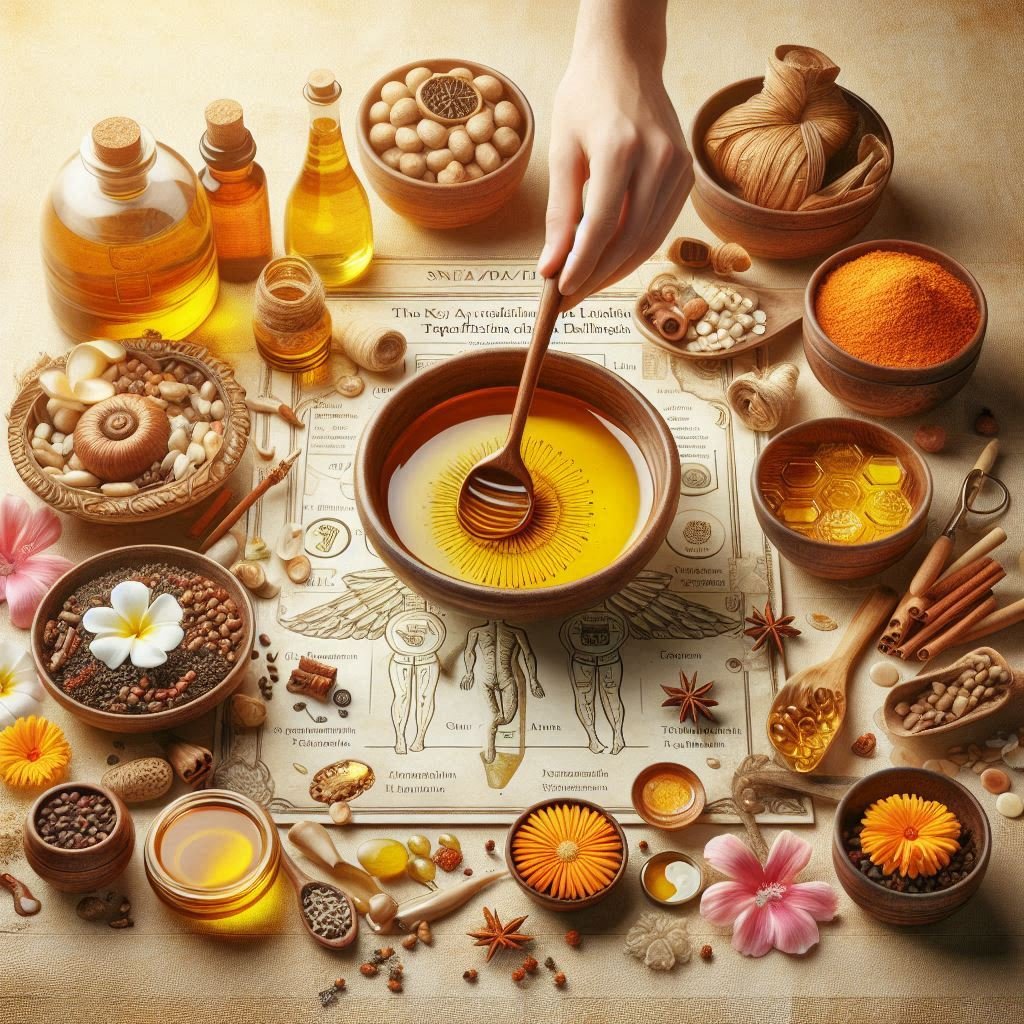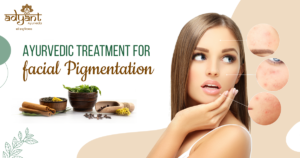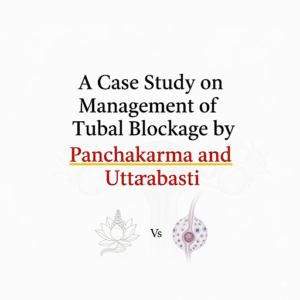Table of Contents
Toggle
Introduction to Snehapana Ayurvedic Treatment
Snehapana, a key preparatory procedure in Ayurveda, plays a crucial role in detoxification and holistic healing. It involves the consumption of medicated ghee or oils and is an integral part of Panchakarma therapy. This Ayurvedic treatment not only detoxifies the body but also rejuvenates tissues, making it a preferred choice for those seeking comprehensive wellness.
For a free Ayurvedic Consultation with top Ayurvedic doctors, download our app from Play Store “AyurCare“
What is Snehapana?
Snehapana, derived from the Sanskrit words ‘Sneha’ (oil) and ‘Pana’ (consumption), is a therapeutic Oleation therapy involving the oral intake of medicated ghee or oil. It helps prepare the body for deeper detoxification processes by lubricating the internal channels and tissues.
Scientific Basis of Snehapana
During Shodhananga Snehapana, the medicated ghee or oil (especially Moorchita Tila Taila) promotes lipolysis and ketogenesis, encouraging the breakdown of stored adipose tissue for energy. As a result, there is increased mobilization of fatty acids from the adipose tissue into the bloodstream.
The sneha saturates bodily tissues, drawing metabolic waste products into the gastrointestinal tract through osmosis. These are then expelled effectively during the subsequent Virechana therapy. This process improves Agni (digestive fire) and corrects Dhatvagni mandya, which are often impaired in metabolic disorders.
Additionally, Moorchita Tila Taila contains PUFAs and oxysterols that are known to inhibit HMG-CoA reductase, the enzyme responsible for endogenous cholesterol production, thereby supporting lipid profile normalization.
Types of Sneha and Their Clinical Relevance (Missed Content)
| Sneha Type | Indication | Properties |
|---|---|---|
| Moorchita Tila Taila | Obesity, Hyperlipidemia, PCOS | Ushna, Teekshna, Srotovishodhana, Vatakaphahara |
| Ashwagandha Ghrita | Male infertility, Fatigue | Brimhana, Balya, Vrushya |
| Sahacharadi Mezhukupaka | Osteoarthritis, Sandhigata Vata | Anti-inflammatory, Vatahara, strengthens joints |
Snehapana Benefits
Snehapana offers a wide range of health benefits, making it a versatile Ayurvedic therapy:
- Detoxification: Prepares the body for deeper cleansing therapies by drawing toxins into the digestive tract.
- Visceral Fat Reduction: Effective in breaking down stubborn visceral fat deposits around internal organs.
- Joint Mobilization: Enhances joint lubrication, reducing stiffness and improving flexibility.
- Nourishment: Provides essential healthy fats for cellular nutrition and repair.
- Skin Health: Improves complexion and addresses dryness.
- Digestive Health: Strengthens digestion and improves nutrient absorption.
- Mental Clarity: Calms the nervous system and promotes emotional balance.
- Boosts Immunity: Enhances the body’s defense mechanisms by balancing doshas.
Therapeutic Uses of Snehapana
| Health Condition | Therapeutic Benefit |
|---|---|
| Skin Disorders | Helps in psoriasis, eczema, and acne by pacifying Pitta and detoxifying skin tissue |
| Neurological Issues | Nourishes nerves in Parkinson’s, Alzheimer’s, neuropathy, and epilepsy |
| Digestive Disorders | Soothes gut in IBS, hyperacidity, constipation; improves digestion |
| Joint & Rheumatic Diseases | Reduces inflammation and stiffness in arthritis, gout, and ankylosing spondylitis |
| Metabolic Disorders | Aids in weight loss, fatty liver, type 2 diabetes, and improves metabolism |
| Mental Health Issues | Calms the mind in anxiety, depression, and insomnia; enhances clarity and focus |
| Gynecological Conditions | Supports fertility, PCOS, and hormonal balance with specific medicated ghee |
| Autoimmune Conditions | Modulates immunity in thyroiditis, lupus, and psoriatic arthritis |
| Pre/Post-Natal Care | Nourishes mother and fetus, promotes recovery after delivery |
| ENT & Eye Disorders | Useful in chronic eye issues, tinnitus, and headaches by pacifying Vata |
Types of Snehapana Treatment
There are different types of Snehapana therapies, depending on the condition and treatment objectives:
- Achapeya Snehapana: Direct oral intake of medicated ghee.
- Vicharana Snehapana: Ghee is administered mixed with food.
- Avapeedaka Snehapana: Targeted therapeutic Oleation for specific health conditions.
Snehapana Procedure
The procedure involves:
- Preparation Phase: The patient is advised to follow a light diet before starting Snehapana.
- Selection of Sneha: Typically, medicated ghee or oils, such as Mahatiktaka Ghrita or Kalyanaka Ghrita.
- Administration: Gradual increase in ghee consumption over several days.
- Monitoring: Observing signs of proper Oleation, such as oily skin and soft stools.
When to Stop Snehapana?
Snehapana should be stopped when the following signs appear:
- Softness and oiliness in the skin.
- Oiliness in stools and urine.
- Increased appetite.
- A feeling of lightness in the body.
- A sense of clarity in the mind.
These signs indicate proper Olation, and the patient can proceed to the next stage of detoxification.
Snehapana Diet and Food Guidelines
Before Snehapana:
- Light, easily digestible foods, such as khichdi and vegetable soups.
During Snehapana:
- Warm water, light soups, and minimal solid food.
- Avoid fried, spicy, and heavy foods.
- Prefer easily digestible food like rice gruel and cooked vegetables.
Post-Snehapana:
- Gradual reintroduction of solid foods like rice gruel and vegetable soups.
- Avoid processed foods and heavy meals initially.
Snehapana Dosage
The dosage of Snehapana varies based on the individual’s body constitution, digestive capacity, and health conditions. It is generally increased gradually over 3-7 days until proper Oleation is achieved.
Snehapana Side Effects and Management
Possible Side Effects:
- Nausea
- Vomiting
- Loose stools
- Loss of appetite
- Heaviness in the abdomen
Management:
- Adequate rest and hydration.
- Reduce the dose if symptoms persist.
- Using Ayurvedic herbs like Shunthi (ginger) for nausea control.
Myth vs. Fact
Myth: Intake of ghee or oil in Snehapana increases weight and cholesterol.
Fact: Clinical evidence shows that medicated Sneha, when administered correctly, reduces body fat, improves cholesterol levels, and enhances metabolic functions.
Contraindications of Snehapana
| Condition | Reason for Contraindication |
|---|---|
| Severe digestive weakness (Agnimandya) | The body may not properly digest the medicated ghee or oil |
| Acute fever or infections | Oleation may aggravate inflammation and Ama (toxins) |
| Diarrhea or loose motions | Snehapana can worsen the condition by increasing unctuousness |
| Liver disorders with severe jaundice | May overload compromised liver function |
| Severe obesity | Needs cautious use; can increase Kapha if not properly monitored |
| Heart diseases | Heavy ghee/oil intake may strain cardiovascular function in some cases |
| Pregnancy (certain stages) | Not advised during early pregnancy unless specially indicated by an expert |
| Tuberculosis and emaciation | These patients require nourishment, but Snehapana may not be tolerated well |
| Uncontrolled diabetes | High fat intake may affect sugar metabolism adversely |
| Mental confusion or delirium | Patients may not cooperate or respond properly to treatment |
Conclusion
Snehapana is a powerful Ayurvedic therapy with profound detoxification and rejuvenation benefits. It aids in weight loss, dissolves visceral fat, enhances joint mobility, and supports overall health.
To experience personalized Ayurvedic healing, consult the expert doctors at Adyant Ayurveda.
Book your Snehapana therapy at Adyant Ayurveda today! Call 9972541009 for expert consultation.
References
- Oleation – Snehakarma Dose, Benefits, Side Effects, Management
- Snehapana in Ayurveda: Benefits, Uses, and Guidelines
- Snehana Karma
You may also like
Frequently Asked Questions (FAQs)
Who can benefit from Snehapana?
Snehapana is beneficial for individuals undergoing Panchakarma treatment, those looking to detoxify their bodies, or people with conditions like joint stiffness, dry skin, or visceral fat accumulation.
Is Snehapana safe for everyone?
Snehapana is generally safe when administered under the guidance of a qualified Ayurvedic doctor. However, it may not be suitable for people with certain conditions, like severe digestive issues or acute illnesses.
How long does a Snehapana treatment take?
The duration of Snehapana typically ranges from 3 to 7 days, depending on the individual’s constitution and the desired level of Oleation.
What types of oils or ghee are used in Snehapana?
Medicated ghee, such as Mahatiktaka Ghrita, Kalyanaka Ghrita, or other herbal oils, is commonly used, depending on the patient’s health condition.
Can I follow my regular diet during Snehapana?
No, a light and easily digestible diet is recommended before, during, and after Snehapana to support the therapy and enhance its effectiveness.
Are there any side effects of Snehapana?
Some individuals may experience nausea, vomiting, or loose stools. These effects are usually temporary and can be managed with proper care and adjustments in dosage.
How will I know if the treatment is working?
Signs of proper Oleation include oily skin, soft stools, increased appetite, and a sense of lightness in the body.
Can Snehapana help with weight loss?
Yes, Snehapana aids in breaking down visceral fat and detoxifying the body, which can contribute to weight loss as part of a comprehensive Ayurvedic treatment plan.






